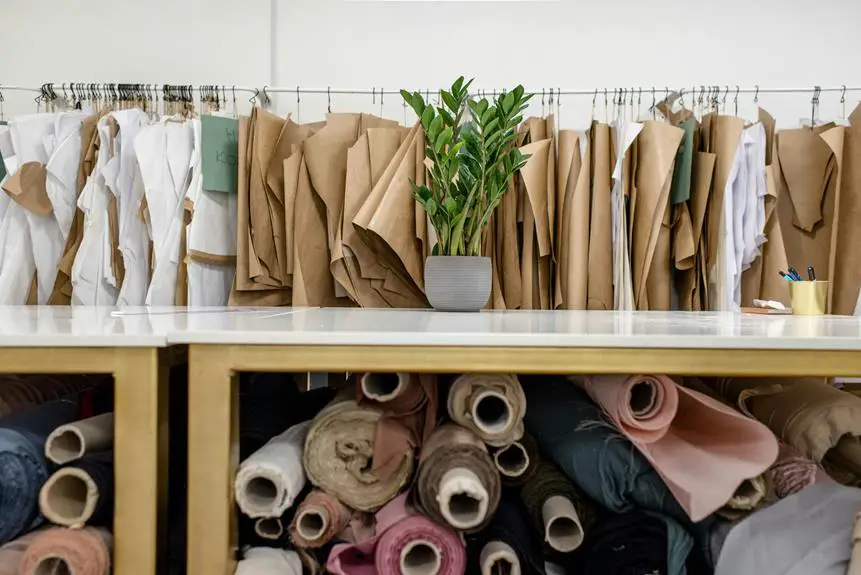When you're deciding between batiste and linen, it's essential to consider what you value most in your fabric choices. Batiste offers a lightweight, soft feel that's perfect for summer attire, while linen boasts durability and breathability, making it a versatile option for both clothing and home textiles. Understanding the unique characteristics of each fabric can significantly impact your decision. So, which attributes matter most to you, and how do they align with your specific needs? Let's explore the key differences and pros and cons that might influence your final choice.
Table of Contents
Overview of Batiste
Batiste is a lightweight, breathable fabric made from cotton or a cotton blend, perfect for warm weather clothing. You'll appreciate its soft texture, which feels gentle against your skin, making it a great choice for shirts, blouses, and dresses. Because of its fine weave, batiste drapes beautifully, enhancing the silhouette of any outfit.
When you choose batiste, you're opting for versatility. It works well for both casual and formal garments, allowing you to create a variety of looks. Its lightweight nature also means it's easy to layer, giving you more styling options throughout the seasons. You'll find it's often used in baby clothes and lingerie, too, owing to its delicate feel.
One of the fabric's standout qualities is its ability to absorb moisture, keeping you cool and comfortable on hot days. Plus, batiste is relatively easy to care for; you can machine wash it, although you should avoid harsh detergents that might damage its fibers.
With its combination of elegance and practicality, batiste is an excellent fabric choice for your warm-weather wardrobe. Embrace the comfort and style that batiste offers, and you won't regret it!
Overview of Linen
Linen is another light and breathable fabric, renowned for its durability and ability to keep you cool in hot weather. Made from the flax plant, it's one of the oldest textiles in the world, and its natural fibers give it a unique texture and appearance. You'll find that linen has a crisp feel that softens with each wash, making it comfortable to wear over time.
Linen is highly absorbent, wicking moisture away from your skin, which is why many people prefer it for summer clothing and home textiles like tablecloths and curtains. It's a great choice if you enjoy a relaxed, laid-back style, as it often has a casual, slightly wrinkled look that adds character to your outfits.
Additionally, linen is hypoallergenic, making it suitable for sensitive skin. Its natural breathability helps you stay comfortable in warmer climates. However, you should be aware that linen can be prone to creasing, which some find charming while others may not.
Key Differences Between Fabrics
When comparing batiste and linen, you'll notice distinct differences in texture, weight, and overall feel that can significantly impact your choice for various clothing and home decor applications.
Batiste is a lightweight, soft fabric, often made from cotton or a cotton blend, giving it a smooth, delicate texture. This makes it ideal for creating airy garments like blouses and dresses, where comfort and breathability are essential.
On the other hand, linen is a heavier, more textured fabric derived from the flax plant. It has a naturally crisp feel and can be a bit rougher compared to batiste. This durability makes linen excellent for structured clothing and home textiles such as tablecloths and curtains, where strength and longevity are crucial.
In terms of drape, batiste flows beautifully, while linen offers a more rigid structure, which can influence how your garments or decor items look and feel.
Lastly, batiste typically requires more care to maintain its softness, whereas linen becomes softer with each wash but may wrinkle easily. Understanding these key differences can help you make an informed choice for your next project.
Pros and Cons
Both batiste and linen have their unique advantages and drawbacks that can influence your fabric choice based on your specific needs.
Batiste is lightweight and smooth, making it an excellent choice for delicate garments like blouses and summer dresses. Its soft texture feels lovely against your skin. However, it can be prone to wrinkling and may require careful washing to maintain its quality.
On the other hand, linen boasts incredible breathability and durability, ideal for warm weather and everyday wear. Its slightly textured feel adds charm to any outfit. But keep in mind, linen wrinkles easily and can feel rougher than batiste, especially when new.
When considering ease of care, batiste often wins, as it usually requires less ironing compared to linen. Yet, linen becomes softer and more comfortable with each wash, which is a significant plus.
Ultimately, your choice boils down to what you prioritize. If you want something soft and lightweight, batiste is your go-to. If you prefer a more rugged, breathable option, linen's the way to go.
Either way, both fabrics can serve you well, depending on your intended use.
Choosing the Right Fabric
Choosing the right fabric depends on your specific needs and preferences, so consider factors like comfort, breathability, and ease of care.
If you're looking for something lightweight and soft, batiste could be the ideal choice. It feels gentle against your skin, making it perfect for delicate garments or warm-weather clothing. However, keep in mind that batiste tends to wrinkle easily and may require more frequent washing.
On the other hand, if you value durability and natural texture, linen is hard to beat. It's breathable and has excellent moisture-wicking properties, which keeps you cool in summer. Linen's unique texture gives it a casual elegance, making it suitable for both relaxed and formal settings. That said, it can be stiffer than batiste and also has a tendency to wrinkle.
Think about how you'll use the fabric. If you're crafting a summer dress, you might lean toward batiste for its softness. But if you're making a tablecloth or curtains, linen's sturdiness could be more advantageous.
Weigh these aspects to find the fabric that best aligns with your lifestyle and aesthetic preferences.
Frequently Asked Questions
Can Batiste Fabric Be Used for Outdoor Clothing?
Batiste fabric isn't ideal for outdoor clothing due to its lightweight and delicate nature. You'll want something more durable and weather-resistant for outdoor activities. Consider fabrics like nylon or polyester for better protection and longevity.
Is Linen More Eco-Friendly Than Batiste?
Yes, linen's generally more eco-friendly than batiste. It's made from flax, which requires less water and pesticides. You'll appreciate its natural durability and biodegradability, making it a sustainable choice for your wardrobe.
How Do Batiste and Linen Handle Dyeing Processes?
When dyeing, batiste absorbs colors well, resulting in vibrant hues. Linen, being more textured, may require different techniques for even dye application. You'll find that both fabrics offer unique qualities in handling dye processes.
What Are the Best Care Tips for Batiste?
To care for batiste, wash it gently in cold water, avoid harsh detergents, and never wring it out. Instead, lay it flat to dry, and iron it on a low setting while still slightly damp.
Can Batiste Be Blended With Other Fabrics?
Yes, you can blend batiste with other fabrics. Combining it with cotton or silk enhances its softness and breathability while maintaining a lightweight feel. Experimenting with blends can create unique textures and improve overall durability.
- Is Corduroy Windproof? Exploring Its Weather Resistance Properties - July 7, 2025
- Is Corduroy Supposed to Be Dry Cleaned? Fabric Care Tips - July 7, 2025
- Corduroy Pants in Style 2021: A Trendy Fabric Guide - July 7, 2025







